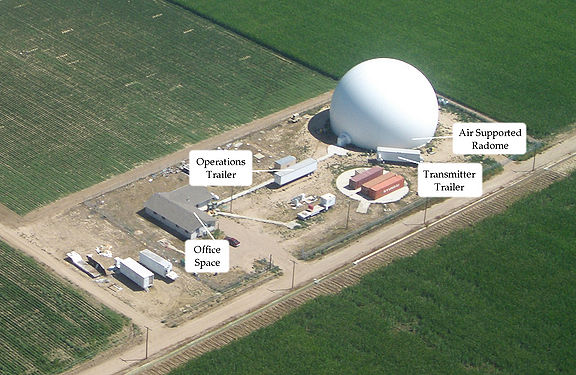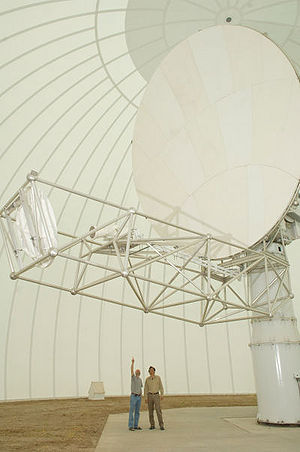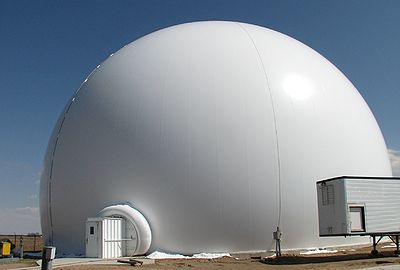CSU-CHILL S- and X-band
CSU-CHILL
| Deployment Type | Ground-based |
|---|---|
| Frequency | 2.725 GHz (S-band) |
| Operating Modes | ATSR, STSR, LDR |
| Range Resolution | 30-150m |
| Typical Range | 120-300 km |
| Antenna | 8.5m (1 °) |
| Transmitter | Dual Klystron (1 MW) |
| Receiver | CSU CDP |
 |
|
| Frequency | 2.725 GHz (S-band) |
|---|---|
| Operating Modes | ATSR, STSR, LDR |
| Range Resolution | 15-150m |
| Typical Range | 50-300 km |
| Transmitter | Dual Solid-State (24 kW) |
| Receiver | CSU DXR |
| Frequency | 9.41 GHz (X-band) |
|---|---|
| Operating Modes | STSR |
| Range Resolution | 15-90m |
| Typical Range | 75-90 km |
| Antenna | 8.5m (0.3 °) |
| Transmitter | Magnetron (25 kW) |
| Receiver | CSU/CASA Signal Processor |
CSU-CHILL S- and X-band is a dual-wavelength S- and X-band, dual polarization scanning radar system located at the CSU-CHILL main site. The S-band transmitter can be selected between dual 1 MW Klystron transmitters or solid-state 24 kW transmitters. The X-band transmitter is a 25 kW magnetron. The antenna is an 8.5m dual-offset (1° at S-band, 0.3° at X-band).
The radar in its current form is designed to provide very high purity polarimetric data thanks to its unique offset-feed antenna design. The dual-wavelength capability with S- and X-band simultaneous operation is unique in the research radar community. The radar offers high spatial resolution at X-band thanks to the combination of short wavelength and large aperture antenna.
The radar site is located at the CSU-CHILL main site in Greeley, CO.
Technical Overview

Antenna
CSU-CHILL has a unique dual-offset, dual-polarization, dual-frequency antenna system. The offset-fed Gregorian antenna offers very good sidelobe performance in excess of -35 dB since the antenna feed structure is entirely out of the path of the main beam. This presents the smallest obstruction to the main beam, and reduces the chance of diffraction along the antenna structure. This, combined with a symmetric ortho-mode transducer (OMT) provides exceptional cross-pol isolation in excess of 50 dB (at boresight). Integrated over the width of the main beam, the integrated cross-pol ratio (ICPR) is about -37 dB, which is verified through linear depolarization (LDR) measurements in light rain.

The antenna is housed within an inflatable radome, for protection against wind loading and corrosion. The radome is 20 m (65 ft) tall, and 35 m (115 ft) in diameter. It is constructed from low-loss microwave-transparent materials, and is coated with . An inflated structure is chosen to minimize construction costs for such a large structure.

Transmitter and Receiver
The radar hardware is housed within the radar trailer, which contains the transmitters, receivers and control subsystems. The digitized signals from the receiver are passed through fiber-optic cables to the operations shelter, which contains the signal processors and storage archives.
The S-band transmitters are controlled by a flexible digital waveform generator, which can synthesize a variety of polarization states. The low-noise receivers are connected to a customized signal processing system, which can output various polarimetric moments. Moment data, as well as raw time series data can be archived for later study.
Further reading
Technical details of the CHILL radar are described in the ![]() CSU-CHILL Technical Brochure
CSU-CHILL Technical Brochure  . A more detailed description of the hardware and software architecture of CHILL is given in the hardware description.
. A more detailed description of the hardware and software architecture of CHILL is given in the hardware description.
Deployments
Main article: CSU-CHILL Projects and Deployments
CSU-CHILL has a long history of field deployments and projects in support of the scientific community.
Requesting Use of the Facility
Projects conducted at the facility can be classified into
Major Projects
These projects usually involve moving the radar, larger time scales of observation (typically in excess of 20 hours) and requires the involvement and funding from the National Science Foundation (NSF). Please contact the Scientific Director for details on requesting the use of the facility.
Cost-recovery
These are larger projects that do not involve funding from the National Science Foundation. A daily use fee will be charged during the data collection process. Please contact the Scientific Director for details on requesting the use of the facility.
20-hour Projects
20 hour projects were conceived as a method to provide simplified access to the radar for users with specific data collection requirements that can be supported with modest facility effort, typically, no more than ~20 hours of radar operational time. 20 hour project investigators (and often their students) also gain valuable experience in the overall planning and conduct of meteorological field research activities.
20 hour projects have secondary priority to the support of NSF-allocated research projects. Their support is also contingent upon scheduled radar maintenance/upgrade activities and facility staff availability. 20 hour project expenses are currently provided by the facility’s NSF base funding.
To request a 20-hour project, please Fill out the Small project application form.
References
- Brunkow, D., V. N. Bringi, P. C. Kennedy, S. A. Rutledge, V. Chandrasekar, E. A. Mueller, and R. K. Bowie, 2000: A Description of the CSU–CHILL National Radar Facility. J. Atmos. Oceanic Technol., 17, 1596–1608.
- Bringi, V. N., R. Hoferer, D. A. Brunkow, R. Schwerdtfeger, V. Chandrasekar, S. A. Rutledge, J. George, and P. C. Kennedy, 2011: Design and Performance Characteristics of the New 8.5-m Dual-Offset Gregorian Antenna for the CSU–CHILL Radar. J. Atmos. Oceanic Technol., 28, 907–920.
- Junyent, F., V. Chandrasekar, V. N. Bringi, S. A. Rutledge, P. C. Kennedy, D. Brunkow, J. George, and R. Bowie, 2015: Transformation of the CSU–CHILL Radar Facility to a Dual-Frequency, Dual-Polarization Doppler System. Bull. Amer. Meteor. Soc., 96, 975–996.